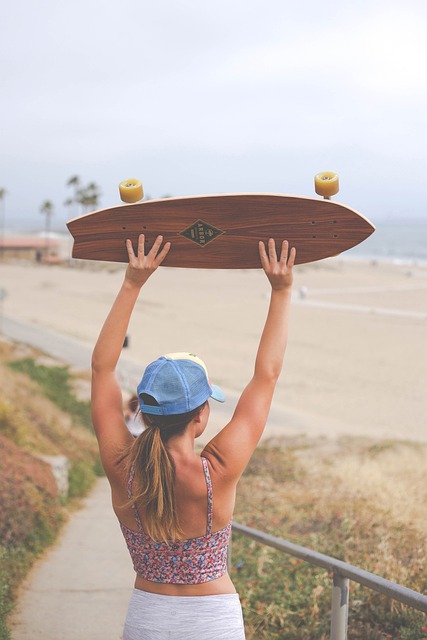For new longboarders, understanding your riding style is crucial when selecting equipment. Choose a board tailored to your preference – cruising, carving or freestyle – and ensure it's the right size. Classic cruising styles offer stability and ease for beginners to build confidence. Modern trends include hybrid decks, drop-through platforms, and advanced shapes for enhanced performance and aesthetics. Longboards cater to diverse skill levels with customizable features, making them an accessible entry point into this global sport influenced by regional traditions.
Longboarding is more than just cruising down the street; it’s an art form with a diverse range of styles catering to every rider’s unique preferences. For those new to this exciting world, understanding your riding style is the first step to mastering the board. This article guides you through the essentials, from identifying your riding preferences to exploring global cultural influences. Whether you’re drawn to classic traditions or modern innovations, we’ve got you covered with our comprehensive breakdown, perfect for longboarders of all levels, especially beginners looking to find their style.
Understanding Your Riding Style: Identifying Your Preferences

Understanding your riding style is a crucial first step, especially for those new to longboarding like many beginners on longboards. It’s not just about the type of board you choose; it’s about aligning your board with how you naturally move and what feels right for you.
For instance, some riders prefer cruising at a relaxed pace, enjoying the flow of the ride and the scenery. Others might be more inclined towards carving, performing smooth, flowing turns that mimic surfing. There’s also freeride, which involves navigating varied terrain with a mix of sharp turns, jumps, and tricks. Identifying your preferred riding style will help guide you when selecting a longboard for beginners, ensuring a board that enhances your natural inclinations rather than hindering them.
The Basics of Longboarding for Beginners: Essential Equipment

Starting out on a longboard is an exciting journey, and having the right equipment is key to a fun and safe experience. For beginners, the most important piece of gear is, of course, the board itself. Choose a longboard designed for your style—whether you’re into cruising, carving, or dancing—and ensure it’s the right size for your height. A deck made from 7-10 layers of maple and bamboo offers a balance between strength and flexibility.
Next, invest in good quality trucks and wheels. Trucks provide the connection between the board and wheels, allowing you to turn and maneuver. Look for trucks with a medium-to-stiff suspension for better control. Wheels come in various durometers (hardness levels) and sizes; softer wheels offer more grip for carving and dancing, while harder wheels provide smoother rides and faster speeds. Don’t forget protective gear: knee and elbow pads are essential for beginners to avoid falls and injuries.
Classic Styles: Traditional and Timeless Approaches

Classic styles in skateboarding, such as traditional and timeless approaches, offer a solid foundation for beginners looking to get their feet wet with a longboard. The traditional style emphasizes smooth, flowing lines and controlled turns, making it easier for newcomers to learn balance and carving techniques. This method focuses on the enjoyment of cruising and navigating through urban environments with grace and agility.
For those new to longboarding, adopting a classic style provides an excellent starting point. It teaches fundamental skills that can be transferred to more advanced maneuvers later. With a traditional approach, beginners can focus on building confidence, understanding the board’s response to their movements, and appreciating the art of smooth, flowing rides—a far cry from the chaotic rush of some modern styles.
Modern Trends: Innovative Styles for Contemporary Riders

In today’s digital era, longboarding has evolved far beyond traditional styles, offering a diverse range of innovative trends that cater to contemporary riders. One notable trend is the rise of hybrid decks, combining elements from both classic and modern designs. These versatile boards are perfect for beginners looking to explore various riding techniques, as they offer stability and maneuverability in one package.
For those seeking an immersive experience, drop-through platforms have gained popularity. This design places the rider lower to the ground, enhancing control and comfort. Moreover, many longboards now feature advanced shapes, concaves, and cutouts that not only improve performance but also add a modern aesthetic appealing to both new and experienced riders considering a longboard for beginners.
Adaptive Styles: Customizing for Individual Needs and Abilities

In the realm of longboarding, one of the most exciting aspects is its adaptability to cater to a wide array of styles and skill levels—particularly when it comes to catering to individual needs and abilities. For beginners, longboards offer a forgiving platform for learning balance and carving turns. Adaptive styles on these boards allow for customization based on personal preference and physical capabilities. For instance, some longboards have flexible decks that absorb impact, making them suitable for riders with joint sensitivities or injuries.
These boards can also be tailored to different riding styles, from cruising and carving to dancing and freestyle tricks. The use of diverse materials and designs enables beginners to find a board that not only suits their learning curve but also enhances their overall experience. Adaptive styles ensure that longboarding remains accessible and enjoyable for everyone, fostering a vibrant and inclusive community on the boards.
Cultural Influences: Global Variations in Longboard Design and Riding

Longboards, with their versatile design and smooth ride, have captivated riders worldwide, offering a unique experience for both seasoned veterans and newcomers. One aspect that makes longboarding so enchanting is its cultural diversity, where regional traditions and aesthetics significantly influence board design and riding styles. For instance, in North America, longboarding has seen the rise of creative shapes inspired by urban environments, with brands crafting boards that cater to technical street tricks and carving maneuvers. In contrast, Asia showcases a distinct style characterized by longer, thinner boards optimized for speed and flowing turns. These variations provide an exciting spectrum for beginners to explore, as they can choose a board that aligns with their cultural connections or simply suit their preferred riding aesthetics.
Global communities have embraced longboarding, leading to diverse riding cultures. European enthusiasts often favor minimalist designs with a focus on precision and technical skills, while South American riders embrace a more playful approach, incorporating freestyle tricks into their routines. These cultural influences not only shape board design but also encourage unique riding techniques, ensuring that the longboard experience is as varied as the regions themselves, making it an attractive entry point for beginners seeking to immerse themselves in this captivating sport.
